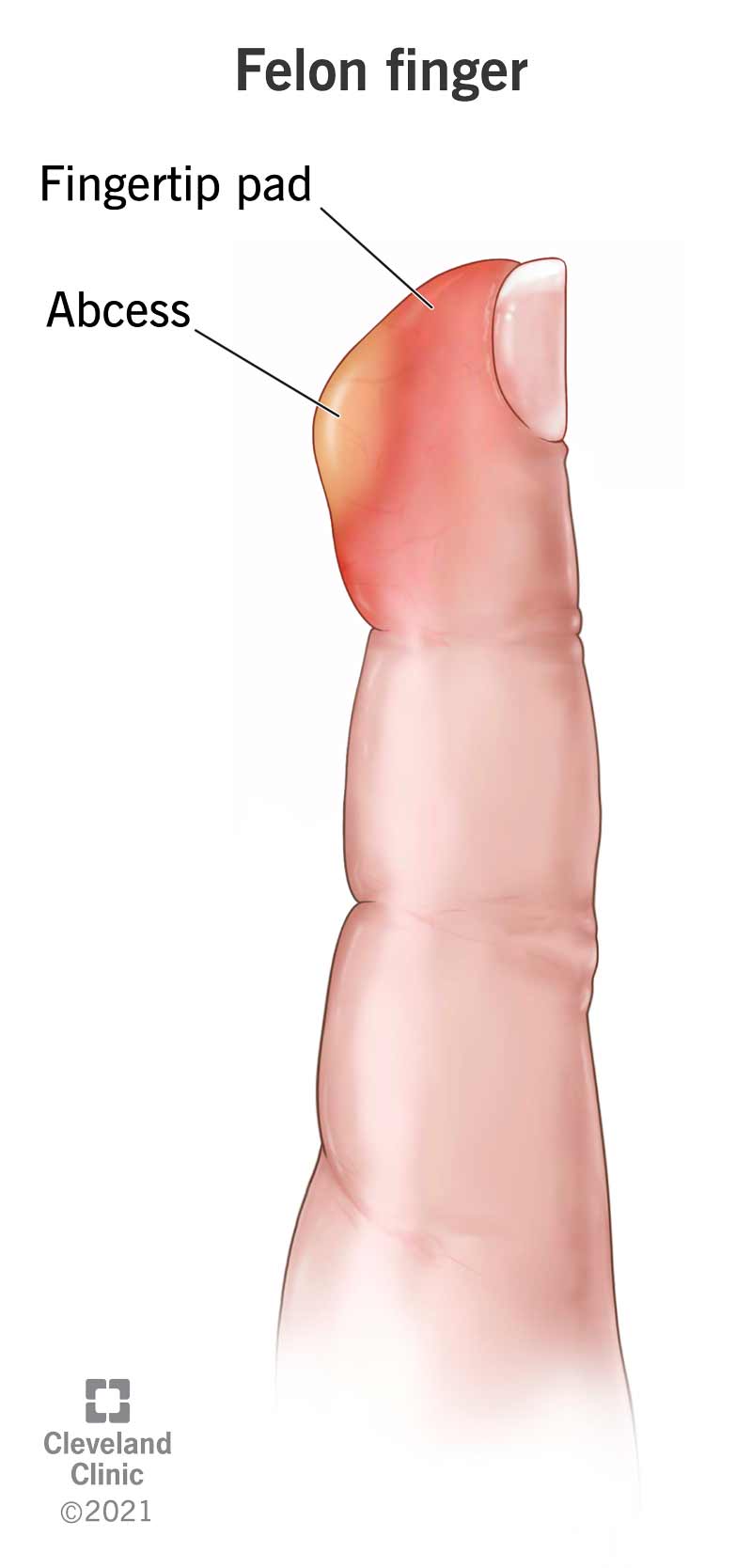Felon finger is a bacterial infection in the pad of your fingertip. It causes pain, swelling and redness. If not treated immediately, a pus-filled sac (abscess) can form. Early-stage felon finger infections can usually be treated with antibiotics. Once an abscess forms, the felon usually needs surgically drained.
Advertisement
Cleveland Clinic is a non-profit academic medical center. Advertising on our site helps support our mission. We do not endorse non-Cleveland Clinic products or services. Policy

A felon finger infection (also known as a felon or felon finger) is a painful infection in the fleshy part of your fingertip. This area is called the distal digital pulp. The infection can form a pocket of pus (abscess) within your fingertip. A felon can take over the pad of your fingertip and the soft tissues surrounding it.
Advertisement
Cleveland Clinic is a non-profit academic medical center. Advertising on our site helps support our mission. We do not endorse non-Cleveland Clinic products or services. Policy
Hand infections near the surface of your skin (superficial) are more common than deep infections. Felons and nail infections (paronychias) are the most common hand infections. Almost one-third of hand infections are felons and paronychias.
The most common location of felon finger infections is in the first and second fingers of your hand. Your fingertips contain closed-up sections of fibrous membranes. When you get a felon finger infection, it begins to swell and throb because it’s trapped within these membranes.
Felon finger is a bacterial infection. When you injure or irritate your fingertip, you create a small opening in your skin. Bacteria can enter this break in your skin, where they can grow and multiply. This can create a felon. Staphylococcus aureus and Streptococcus are the most common bacteria that lead to felons.
Felon finger infections are usually caused by minor injuries to your finger pads. These injuries can include:
They may also develop due to an untreated nail infection (paronychia).
The signs and symptoms of a felon finger include redness and warmth in your fingertip. You may also experience:
Advertisement
A felon finger will look red and swollen. You may notice a red bump on the tip of your finger. Later, a pus-filled bump may appear.
Your healthcare provider will typically be able to diagnose a felon through a physical examination of your finger. Your healthcare provider will ask you about your symptoms. They’ll also ask you about your medical history and any recent injuries to your fingertip.
Your healthcare provider can usually diagnose felon finger through a clinical exam. However, they may request additional tests. Your healthcare provider may want an ultrasound to check for evidence of an abscess under the skin. They may also order a wound culture. A wound culture can determine what kind of bacteria caused the felon. This helps your healthcare provider decide which infection-fighting medication (antibiotic) to prescribe you.
If an abscess hasn’t formed yet, your healthcare provider may treat your felon finger with oral (by mouth) antibiotics. In addition, your healthcare provider may instruct you to soak your finger in warm water and keep your finger elevated. If you punctured yourself, your healthcare provider may recommend getting a tetanus shot.
If an abscess has developed, your healthcare provider will need to surgically drain the abscess. They need to drain the abscess to remove the infected material. First, your healthcare provider will give you a pain-blocking medication (anesthetic) to numb your finger. They will inject the medication into each side of your finger beyond your knuckle. Then, your healthcare provider will make one or more cuts (incisions) on your fingertip. This will allow the pus to drain.
Your healthcare provider will wrap your finger in gauze and put it in a splint. After two to three days, your healthcare provider will remove the gauze and reexamine your finger. If your finger looks like it’s beginning to heal, your healthcare provider will have you change the gauze daily to keep the wound clean until it heals. If there’s been no improvement, you may need further surgery. Your healthcare provider may also prescribe you an antibiotic to prevent further infection.
Depending on the severity and treatment of your infection, your felon finger may clear up within days or weeks. If you have a more aggressive treatment, your felon finger may heal faster.
In the early stages of an infection, your healthcare provider can usually treat a felon finger infection with antibiotics. They'll instruct you to soak your finger in warm water and keep it elevated. In later stages of an infection, an abscess can form and your healthcare provider may need to drain the felon. It’s important to see your healthcare provider early. Delayed treatment can lead to long-term complications. However, prompt treatment can lead to a good prognosis.
Advertisement
Felon finger is frequently caused by injuries to your fingertips or untreated nail infections. There are several ways to prevent felon finger:
Get nail infections (paronychias) treated immediately.
Felon finger infections can be very serious and don’t go away on their own. It’s important to see your healthcare provider as soon as a felon starts to develop. With early medical care, antibiotics and warm soaks may be all you need. Once an abscess develops, the blood supply to your finger goes down, which makes it hard for your body’s immune system to fight off the infection. You’ll most likely need the felon surgically drained.
Without prompt treatment, a felon can compress the blood vessels in your finger. This can cut off your fingertip’s circulation and cause permanent damage, tissue death (necrosis) or even loss of your finger. In addition, an untreated felon infection can spread to your finger bones, tendons or joints. This can lead to bone infections (osteomyelitis), tendon infections (tenosynovitis) or arthritis in your joints. Therefore, there are no safe felon finger home remedies. You need to see your healthcare provider for treatment.
Advertisement
If you develop severe pain or swelling in your fingertip, make a trip to your healthcare provider immediately. It’s important to get treatment as soon as possible to minimize complications and risks of felon finger infection.
If you think you might have a felon finger infection, it’s important to see your healthcare provider right away. If treated early, felon finger infections usually only need antibiotics, soaks in warm water and elevation. Once an abscess forms, your healthcare provider will need to drain the felon finger infection. Complications from a felon finger infection are rare and can be avoided with early treatment.
Advertisement
Need care fast? Cleveland Clinic’s Express Care and Urgent Care locations treat everything from sprains to sinus infections — no appointment needed.

Last reviewed on 04/19/2022.
Learn more about the Health Library and our editorial process.